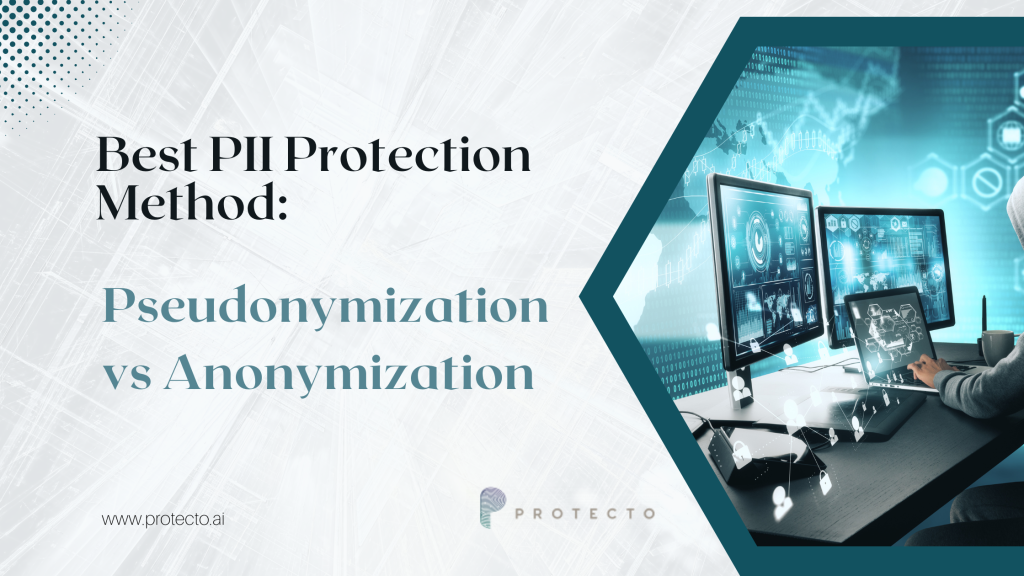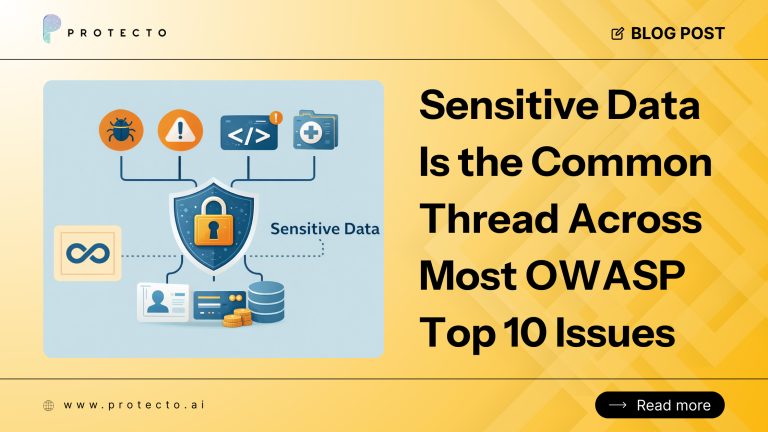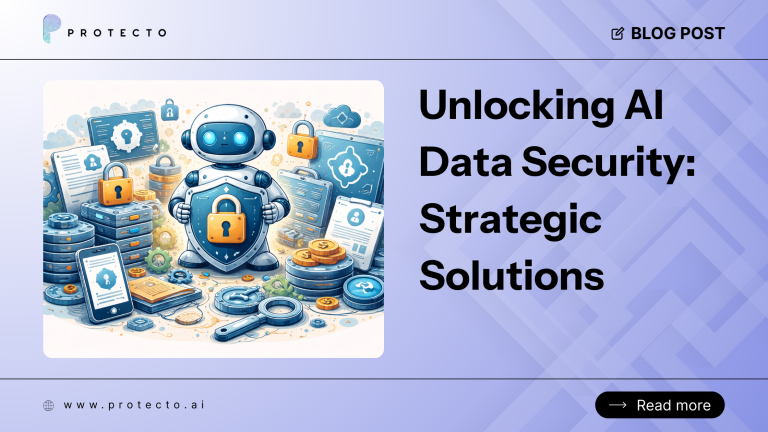When it comes to protecting personally identifiable information (PII), organizations have two main options: pseudonymization and anonymization. Both aim to prevent unauthorized disclosure of sensitive PII data, but they differ in their implementation, advantages, and regulatory implications.
In this blog, we’ll explore the key differences between pseudonymization vs anonymization, their benefits, practical examples, and how to choose the best method for your organization’s needs.
What is Pseudonymization?
Pseudonymization is a process that replaces identifying information with a pseudonym, a random value (alphabetical, numerical, or alpha-numerical) that does not reveal the subject’s identity. While pseudonymized data cannot be used to identify a person without additional information, it is still considered PII under GDPR regulations.
Examples of Pseudonymized Data:
Here are some examples of data that can be pseudonymized:
- Names: First and last names can be replaced with a pseudonym or identifier to help protect personal information. Replaced with unique identifiers (e.g., John Doe → User1234)(pseudo-anonymization).
- Addresses: Modified while retaining general location data. Street addresses, postal codes, and other location data can be pseudonymized to prevent identification.
- Identification Numbers: Social Security numbers, national identification numbers, and other unique personal identifiers can be pseudonymized to help prevent identity theft.
- Medical Data: Personal health information such as diagnoses, test results, and prescription data can be pseudonymized to protect patient privacy.
- Financial Data: Bank account numbers or credit card details can be substituted with tokens to help prevent fraud and financial theft.
Example of Pseudonymization
Let’s consider a dataset containing information about individuals’ financial records. The dataset contains the following columns: “Name,” and “Credit Card” information.
.png)
The above pseudonymized data is now secure to be utilized freely by any user in areas such as application development and testing environments, training programs, as well as business and analysis processes.
Benefits of data pseudonymization
Data pseudonymization offers several benefits, including:
- Enhanced Data Privacy:
Pseudonymization can help protect sensitive data and prevent unauthorized access, breaches, and data theft. - Regulatory Compliance:
Many national regulations require data controllers and processors to protect personal information. Pseudonymization helps organizations comply with GDPR, HIPAA, and other data privacy regulations, reducing the risk of legal and financial penalties. - Secure Data Sharing:
Pseudonymization can allow for secure data sharing between organizations or departments with the necessary authorization controls in place, while still protecting the privacy of individuals. - Improved Data Analytics:
Pseudonymization can allow for detailed data analysis while still protecting the privacy of individuals. This can be especially useful in medical, financial or research fields where detailed data analysis is required. - Business Continuity:
In the event of a data breach, pseudonymization can help ensure that the data cannot be easily used to harm individuals or organizations.
Interesting Read: How Pseudonymization Can Be Key to A Robust Data Privacy Strategy
What is Anonymization?
Anonymization is a process that removes all identifying information from data, making it impossible to identify the data subject. Unlike pseudonymization, anonymized data cannot be used for any purpose that requires identifying information. Once anonymized, data is no longer considered PII and is exempt from GDPR.
Examples of Anonymized Data:
Here are some examples of data that can be anonymized:
- Demographic data: Age, gender, ethnicity, or location data can be anonymized.
- Financial data: Financial transactions or credit card data can be anonymized.
- Healthcare data: Medical test results, diagnoses, or treatment information can be anonymized.
- Web browsing data: Web browsing history, search queries, or social media activity can be anonymized.
- Survey data: Survey responses or feedback can be anonymized.
It’s worth noting that the ability to anonymize data depends on the type and amount of data being collected. In some cases, it may not be possible to fully anonymize data while still retaining its usefulness for analysis or research purposes.
Common Methods of Anonymization:
Here are some common methods to anonymize data:
- Data Aggregation:
Combine or group individual data points to create aggregated data. This makes it challenging to identify specific individuals from the dataset. For example, instead of sharing the ages of individual customers, you could share age ranges like 20-30, 30-40, etc.
- Generalization:
Modify the data to a less precise or generalized form. For instance, replacing exact income values with income brackets (e.g., $50,000 – $60,000) or reducing geographic specificity (e.g., city to state).
- Data Masking/Redaction:
Remove or mask sensitive information from the dataset. For example, redacting Social Security Numbers, email addresses, or phone numbers. Replace identifiable information with pseudonyms or random identifiers. This process retains the data’s usability for analysis while protecting the individuals’ identities. For instance, replacing individuals’ names with unique IDs.
- Adding Noise:
Introduce random noise to the data to obscure specific details while preserving the overall statistical properties.
- Data Swapping:
Replace original data points with those from another individual in the dataset. This process helps to maintain the dataset’s structure and statistical properties while hiding individual identities.
- Differential Privacy:
A formal privacy framework that adds controlled noise to the data to provide a strong guarantee of privacy protection while preserving data utility for analysis.
Example of anonymization
Let’s consider a dataset containing information about individuals’ health records. The dataset contains the following columns: “Name,” and “Medical Diagnosis.”

In this example, the data has been anonymized by replacing individual names, and leaving the diagnosis unchanged as they do not contain directly identifiable information. This anonymization process helps protect the individuals’ identities while preserving the dataset’s analytical value.
With anonymization, personal identifiers are permanently removed, ensuring privacy protection.
Suggested Read: Data Anonymization’s Critical Role in Protecting Data Privacy
GDPR Requirements for Pseudonymization & Anonymization
Anonymization and pseudonymization are both essential data protection strategies under GDPR that can assist companies in safeguarding personal data, wherever possible. Nevertheless, they are not a panacea.
Even though genuinely “anonymized” data is not subject to GDPR, the criteria for complying with this definition are so stringent that a data controller must exercise great caution before employing anonymization as a means of completely avoiding GDPR obligations.
Pseudonymization is a recognized de-identification technique that has received increased attention since the implementation of GDPR, where it’s recognized as a mechanism for both security and data protection by design. As a result, in the context of GDPR, the proper application of pseudonymization can alleviate some of the legal obligations of data controllers to a certain extent.
Under GDPR, anonymized data is not considered PII and falls outside regulatory obligations. However, pseudonymized data is still considered PII since it can be re-identified using additional data.
Pseudonymization is a recognized technique under GDPR for reducing compliance burdens, while anonymization helps organizations eliminate regulatory risks entirely. Companies must evaluate their data use cases, compliance needs, and security requirements before choosing a method.
- Anonymized Data: No longer considered PII; not subject to GDPR.
- Pseudonymized Data: Still considered PII under GDPR as it can be re-identified.
- Pseudonymization vs Encryption: Encryption protects data via cryptographic means, whereas pseudonymization alters the data format while retaining usability.
Pseudonymization vs Anonymization: What’s Best for PII?
| Feature | Pseudonymization | Anonymization |
| Reversible | Yes, with key | No |
| GDPR Compliance | Still PII | Not considered PII |
| Data Utility | High | Limited |
| Security Level | Medium | High |
| Best For | Research, Testing | Compliance, Third-Party Sharing |
- Use pseudonymization if identifiers are needed for business processes, such as customer service or fraud prevention.
- Use anonymization when strict privacy compliance and irreversible data protection are required.
Different teams within an organization may prefer data masking techniques based on their specific needs. For example, while customer support teams may require reversible pseudonymization, software testers may opt for strict anonymization.
The answer to this question depends on the specific use case and the level of privacy required for an organization. If the data needs to be used for analysis, statistical purposes or research, pseudonymization may be the best option, as it allows for the use of the data while still protecting the privacy of the data subject.
On the other hand, if the data needs to be kept completely anonymous, or where organizations need to completely erase PII from the data. Anonymization may be the best option. This is often the case in situations where data is being shared with third parties, such as in data breaches, where the data must be completely anonymous to prevent further harm to the data subjects.
Deciding between pseudonymization and anonymization can have implications for legal compliance, security, and data usability. From a legal standpoint, since pseudonymized data can be re-identified to some extent, it’s still regarded as Personally Identifiable Information (PII) and is therefore subject to regulations such as GDPR, unlike anonymized data.
Consequently, if an organization requires access to identifiers for its internal business purposes, it will likely favor pseudonymization. However, if a company aims to evade regulatory responsibility altogether, it will likely choose anonymization for its sensitive data.
Within an enterprise, different teams may have varying preferences for data masking techniques based on their specific needs. For example, while customer support may require reversible data pseudonymization tools to access PII in call centers, software testing teams may opt for data anonymization tools due to their stringent security protocols.
In conclusion, both pseudonymization and anonymization are effective methods for protecting PII, and the best method will depend on the specific use case and the level of privacy required. When in doubt, it’s always best to err on the side of caution and choose the method that provides the highest level of privacy protection.
How Tokenization Helps in Pseudonymization & Anonymization
Tokenization involves replacing sensitive data with randomly generated tokens not derived from the original data but linked to it securely. Tokens can be used to reference the original data without revealing sensitive information and are often secured in a Vault to further safeguard the data, enhancing data masking over anonymization.
Tokenization can be a valuable technique in both pseudonymization and anonymization processes to protect sensitive data while maintaining data utility. Here’s how tokenization can help in each case:
How Tokenization Works:
- For Pseudonymization: Tokens replace sensitive data but can be mapped back using access controls.
- For Anonymization: Tokens are generated without any retraceable link to the original data.
Pseudonymization:
The tokens generated during tokenization are usually random, irreversible, and not derived from the original data. This way, even if someone gains access to the pseudonymized data, they cannot reverse-engineer it to reveal the original PII without the associated key.
For example, instead of storing credit card numbers directly, a system can use tokenization to generate unique tokens for each credit card number. These tokens are stored alongside the original data, but the actual credit card numbers are kept in a secure, separate location, only accessible through a key. This way, if a data breach occurs, the exposed tokenized data is useless without access to the key.
So, while both pseudonymization and tokenization can be used to de-identify data, tokenization goes a step further by not only replacing the identifying information but also creating a unique, secure reference to the original data that can be used for processing and analysis without compromising its security.
Anonymization:
Tokenization can aid anonymization by helping to remove direct identifiers from the data. For example, instead of using names, email addresses, or social security numbers directly in a dataset, you can tokenize these identifiers and replace them with unique tokens. By doing so, the original identifying information is obscured, and the data becomes more anonymous.
In summary, tokenization can be a powerful tool for both pseudonymization and anonymization, providing an additional layer of security and privacy to sensitive data while preserving data utility for analysis and processing.
Also Read: Pseudonymization’s Role in Data Privacy Protection and Analytics
How Protecto’s Intelligent Tokenization Can Help Safeguard Your PII Data
In today’s digital world, protecting personally identifiable information (PII) is a top priority for individuals and organizations alike. The risks associated with data breaches and cyber-attacks are real and can have severe consequences, including financial loss, reputational damage, and legal liability. That’s where Protecto’s Intelligent Tokenization comes in as a reliable solution to safeguard your PII data.
Protecto’s Intelligent Tokenization provides:
- Enhanced Data Security: Protects against data breaches and unauthorized access.
- Regulatory Compliance: Aligns with GDPR, HIPAA, and CCPA standards.
- Seamless Integration: Works with cloud and on-premise systems.
- Improved Customer Trust: Ensures users’ data privacy.
If you’re looking for a reliable way to safeguard your PII data, consider implementing Intelligent Tokenization with Protecto. Start a Free Protecto Trial to see how you can discover and mask sensitive data across your business applications or just schedule a demo today.
Frequently Asked Questions
Q: How does anonymization differ from pseudonymization?
A: Anonymization irreversibly removes identifiers, while pseudonymization replaces the identifiers with pseudonyms that can be reversed with the use of additional information.
Q: Which is better, pseudonymization or anonymization?
A: The choice between pseudonymization and anonymization depends on the specific needs of the organization and the data they are working with. Pseudonymization is better if identifiers are needed, while anonymization is ideal for strict privacy compliance.
Q: How does the GDPR regulate the use of pseudonymization and anonymization?
A: The GDPR considers both pseudonymized and anonymized data as “data processing” and requires compliance with the principle of purpose limitation. Additionally, pseudonymized data is still considered PII and subject to GDPR regulations, while truly anonymized data falls outside the scope of the GDPR.
Q: What are the benefits of tokenization for protecting PII?
A: Tokenization is a more secure way to protect PII than anonymization because it keeps the original data intact and only replaces it with a meaningless token. This means that the data can still be used for business purposes, such as analytics while protecting the privacy of the data subjects. Additionally, tokens can be easily reversed, allowing the original data to be accessed when needed.
Q: Can tokenization be used for all types of PII?
A: Yes, tokenization can be used for all types of PII, including names, addresses, credit card numbers, and social security numbers.
Q: Is tokenization compliant with data privacy regulations such as GDPR?
A: Yes, tokenization is compliant with data privacy regulations such as GDPR, as long as the tokenization process does not allow for the re-identification of the data subjects.
By understanding data anonymization vs data masking, organizations can make informed decisions about their data security. Whether you need pseudonymization, anonymization, or tokenization, adopting the right approach ensures compliance, security, and business continuity.




